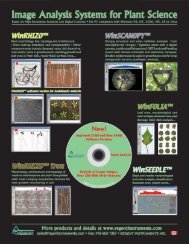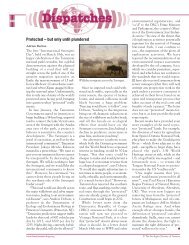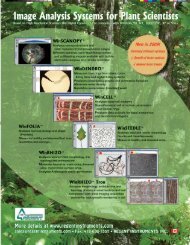Conservation of giant panda habitat in South Minshan, China, after ...
Conservation of giant panda habitat in South Minshan, China, after ...
Conservation of giant panda habitat in South Minshan, China, after ...
You also want an ePaper? Increase the reach of your titles
YUMPU automatically turns print PDFs into web optimized ePapers that Google loves.
Panda <strong>habitat</strong> conservationXu et al.358<strong>of</strong> restoration areas <strong>in</strong> each area <strong>of</strong> damaged <strong>habitat</strong>, particularlythe key areas or corridors, is a critical step. Suchefforts should be placed <strong>in</strong> the context <strong>of</strong> both long-term<strong>panda</strong> <strong>habitat</strong> management plans and the long-termplann<strong>in</strong>g for allocation <strong>of</strong> funds dur<strong>in</strong>g the current reconstructionstage. In order to select restoration sites and thebest approach (eg natural restoration or human-mediatedrestoration), the potential effects <strong>of</strong> restoration can besimulated and assessed, based on a comb<strong>in</strong>ation <strong>of</strong> differentfactors, such as ra<strong>in</strong>fall, soil quality, and human disturbance.These effects can also be assessed via case studiesconducted follow<strong>in</strong>g other disasters, such as the 1976Songpan earthquake (magnitude 7.2), which occurred <strong>in</strong>the same mounta<strong>in</strong> range as the 2008 earthquake.Furthermore, <strong>in</strong>tegrated monitor<strong>in</strong>g systems should beestablished to monitor the long-term process <strong>of</strong> restoration<strong>of</strong> ecological structure and function, rely<strong>in</strong>g on multipleapproaches such as remote sens<strong>in</strong>g and field surveys.The third issue that needs to be addressed concerns conduct<strong>in</strong>gwildlife field surveys, as well as patroll<strong>in</strong>g andmonitor<strong>in</strong>g programs. Dur<strong>in</strong>g the earthquake relief effortsand <strong>after</strong>shocks, such surveys and programs <strong>in</strong> the naturereserves were postponed. These activities should now beresumed <strong>in</strong> the reserves, as well as <strong>in</strong> the proposed key areasand corridors, so as to rescue <strong>panda</strong>s and other wildlifespecies that may have suffered from <strong>in</strong>sufficient access t<strong>of</strong>ood resources due to earthquake damage and subsequent<strong>habitat</strong> fragmentation. Moreover, such efforts will beimportant for determ<strong>in</strong><strong>in</strong>g whether <strong>giant</strong> <strong>panda</strong>s do<strong>in</strong>habit – or at least pass through – these key areas and corridors.Integrated field surveys also need to be carried outthroughout the earthquake-damaged portion <strong>of</strong> the <strong>panda</strong>distribution area, to identify current <strong>panda</strong> distributionpatterns <strong>in</strong> damaged <strong>habitat</strong>. Because <strong>of</strong> the <strong>in</strong>accessibility<strong>of</strong> some zones <strong>after</strong> the earthquake, the cont<strong>in</strong>ued <strong>after</strong>shocks,and other potential dangers, field patroll<strong>in</strong>g andmonitor<strong>in</strong>g <strong>in</strong> the future should be adjusted to avoidpotential harm to field patrol staff. Assessment <strong>of</strong> the risksand the level <strong>of</strong> accessibility throughout the region couldcontribute to the plann<strong>in</strong>g <strong>of</strong> such patroll<strong>in</strong>g activities.The May 2008 Wenshuan earthquake and its <strong>after</strong>mathcaused marked loss and fragmentation <strong>of</strong> <strong>panda</strong> <strong>habitat</strong> <strong>in</strong><strong>South</strong> M<strong>in</strong>shan. In order to conserve the rema<strong>in</strong><strong>in</strong>g <strong>habitat</strong>,we propose establish<strong>in</strong>g protected <strong>habitat</strong> across three keyareas and two corridors outside the current reserve system.This could be <strong>in</strong>corporated <strong>in</strong>to the com<strong>in</strong>g 10-year(2010–2020) plan for conservation <strong>of</strong> the <strong>giant</strong> <strong>panda</strong> andits <strong>habitat</strong> <strong>in</strong> Ch<strong>in</strong>a. Measures <strong>in</strong>clud<strong>in</strong>g relocation <strong>of</strong> residentialareas and ecological compensation (an environmentalprotection policy <strong>in</strong>tended to balance ecological protectionand economic development; Yang et al. 2007) couldpotentially aid <strong>in</strong> the formation and operation <strong>of</strong> such amanagement unit. The exist<strong>in</strong>g National Forest<strong>Conservation</strong> Program and the Gra<strong>in</strong>-to-Green Program aregood examples <strong>of</strong> successful ecological compensation policiesalready <strong>in</strong> place <strong>in</strong> this region. Similar policies shouldalso be <strong>in</strong>troduced throughout the entire earthquake-damagedarea, which could contribute to <strong>habitat</strong> restoration andlong-term conservation <strong>of</strong> the <strong>giant</strong> <strong>panda</strong> and other species.When coupled with <strong>in</strong>creas<strong>in</strong>g human activities, naturaldisasters – <strong>in</strong>clud<strong>in</strong>g earthquakes, tsunamis, and hurricanes– create unprecedented challenges for biodiversity conservation,especially with respect to endangered species. Moreattention needs to be focused on these issues for future biodiversityconservation around the world. AcknowledgementsThis study was funded by a grant from the Major State BasicResearch Development Program <strong>of</strong> Ch<strong>in</strong>a (973 Program,#2009CB421104) and Funds <strong>of</strong> the Ch<strong>in</strong>ese Academy <strong>of</strong>Sciences for Key Topics <strong>in</strong> Innovation Eng<strong>in</strong>eer<strong>in</strong>g. We thankthe Sichuan Forestry Adm<strong>in</strong>istration, WWF, Longxi-hongkouNR Adm<strong>in</strong>istration, and Qianfoshan NR Adm<strong>in</strong>istration forprovid<strong>in</strong>g assistance for field surveys <strong>after</strong> the earthquake. Wegreatly appreciate the provision <strong>of</strong> pre- and post-earthquakeremote-sens<strong>in</strong>g data by NASA and the Center for EarthObservation and Digital Earth, the Ch<strong>in</strong>ese Academy <strong>of</strong>Sciences, and the provision <strong>of</strong> basic spatial data by TheNational Geomatics Center <strong>of</strong> Ch<strong>in</strong>a, as well as the provision<strong>of</strong> the <strong>panda</strong> image by the Ch<strong>in</strong>a <strong>Conservation</strong> and ResearchCenter for the Giant Panda. We also acknowledge V Hull forconstructive comments on this paper. ReferencesCCTV (Ch<strong>in</strong>a Central Television). 2008. News report. CCTV.http://news.cctv.com/ch<strong>in</strong>a/20081008/103396.shtml. Viewed 18Nov 2008.CEA (Ch<strong>in</strong>a Earthquake Adm<strong>in</strong>istration). 2008. www.cea.gov.cn/manage/html/8a8587881632fa5c0116674a018300cf/_content/08_09/01/1220238314350.html). Viewed 18 Nov 2008.Liu JG, L<strong>in</strong>derman M, Ouyang ZY, et al. 2001. Ecological degradation<strong>in</strong> protected areas: the case <strong>of</strong> Wolong Nature Reserve for<strong>giant</strong> <strong>panda</strong>s. Science 292: 98–101.McGarigal K, Cushman SA, Neel MC, et al. 2002. FRAGSTATS:spatial pattern analysis program for categorical maps.www.umass.edu/landeco/research/fragstats/fragstats.html.Viewed 18 Nov 2008.Myers N, Mittermeier RA, Mittermeier CG, et al. 2000. Biodiversityhotspots for conservation priorities. Nature 403: 853–58.Schaller GB, J<strong>in</strong>chu H, Wenshi P, and J<strong>in</strong>g Z. 1985. The <strong>giant</strong> <strong>panda</strong>s<strong>of</strong> Wolong. Chicago, IL: University <strong>of</strong> Chicago Press.Sichuan Earthquake Relief Information Net. 2008. www.eqsc.gov.cn/manage/html/ff808181126bebda01126bec4dd00001/<strong>in</strong>dex.html. Viewed 2 Nov 2008.State Forestry Adm<strong>in</strong>istration. 2006. The Third National Surveyreport on <strong>giant</strong> <strong>panda</strong>s <strong>in</strong> Ch<strong>in</strong>a. Beij<strong>in</strong>g, Ch<strong>in</strong>a: Ch<strong>in</strong>a SciencePress.Wang DJ, Li S, Sun S, et al. 2008. Turn<strong>in</strong>g earthquake disaster <strong>in</strong>tolong-term benefits for the <strong>panda</strong>. Conserv Biol 22: 1356–60.Wang H, Li SG, and Pan WS. 2002. Population viability analysis <strong>of</strong><strong>giant</strong> <strong>panda</strong> (Ailuropoda melanoleuca) <strong>in</strong> Q<strong>in</strong>l<strong>in</strong>g Mounta<strong>in</strong>s.Acta Scientiarum Naturalium Universitatis Pek<strong>in</strong>ensis 38: 756–61.Xu WH, Ouyang ZY, Viña A, et al. 2006. Design<strong>in</strong>g a conservationplan for protect<strong>in</strong>g the <strong>habitat</strong> for <strong>giant</strong> <strong>panda</strong>s <strong>in</strong> the Qionglaimounta<strong>in</strong> range. Ch<strong>in</strong>a Divers Distrib 12: 610–19.Yang GM, M<strong>in</strong> QW, Li WH, et al. 2007. Scientific issues <strong>of</strong> ecologicalcompensation research <strong>in</strong> Ch<strong>in</strong>a. Acta Ecol S<strong>in</strong>ica 27:4289–300.www.frontiers<strong>in</strong>ecology.org© The Ecological Society <strong>of</strong> America









